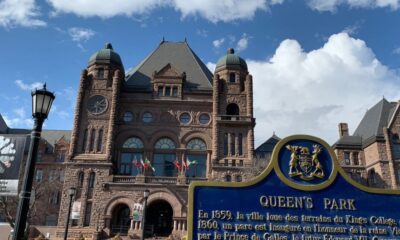Politics
Ontario Colleges Face Job Cuts Amid Funding Crisis

Ontario’s public colleges are experiencing significant job cuts, with more than 8,000 positions eliminated since the federal government imposed restrictions on foreign visa students last year. This development highlights a broader crisis in the province’s higher education system, which has been under strain for several years. While the federal cap on international students has intensified the financial challenges, the root of the crisis is linked to fiscal policies initiated by Doug Ford and his government.
The funding landscape for post-secondary education in Ontario has become increasingly untenable. The job losses at colleges and universities were anticipated, given the ongoing financial strain caused by years of underfunding. The current situation has been exacerbated by the tuition freeze implemented by Ford’s government, which has remained in place since 2019. During that time, the Progressive Conservatives announced a 10 percent cut in tuition fees, a decision that has had lasting repercussions on the financial viability of educational institutions.
Political dynamics in Ontario complicate the situation further. Both the opposition Liberals and New Democrats have aligned with Ford’s tuition freeze, indicating a lack of viable alternatives for funding higher education. This political consensus raises questions about the long-term sustainability of educational funding in the province, particularly as the economic landscape shifts.
The decision to freeze tuition was motivated not by economic necessity but by political strategy, as many Ontarians grapple with the effects of inflation and economic uncertainty. This freeze, while aimed at affordability, has contributed to a significant funding gap that institutions struggle to bridge. The reliance on international students to supplement tuition revenue has proven precarious, particularly following the federal restrictions that have reduced the influx of foreign students.
The impact of these policies extends beyond finances. The Ford government has also targeted student fees, imposing regulations that limit mandatory contributions to student organizations. This approach reflects a broader ideological stance that prioritizes political objectives over the needs of students.
Colleges and Universities Minister Nolan Quinn has faced criticism for these measures, which some view as a misguided attempt to promote affordability. The government’s focus on transparency in admissions criteria has raised concerns among educators, who fear it may lead to a shift towards populist, anti-diversity policies reminiscent of those seen in the United States.
Looking ahead, universities in Ontario are warning that chronic underfunding will hinder their ability to accommodate approximately 80,000 qualified applicants over the next five years. This shortfall comes at a time when the province is attempting to attract foreign investment, leveraging its educated workforce as a key selling point. The disconnect between government policy and the realities of higher education funding poses significant challenges for the future of Ontario’s colleges and universities.
In summary, the combination of job losses, tuition freezes, and an over-reliance on international students underscores the urgent need for a reevaluation of funding strategies in Ontario’s higher education sector. As the province navigates economic challenges, it must also address the long-term sustainability of its educational institutions to ensure they can continue to serve the needs of all students.
-

 World3 months ago
World3 months agoScientists Unearth Ancient Antarctic Ice to Unlock Climate Secrets
-

 Entertainment3 months ago
Entertainment3 months agoTrump and McCormick to Announce $70 Billion Energy Investments
-

 Lifestyle3 months ago
Lifestyle3 months agoTransLink Launches Food Truck Program to Boost Revenue in Vancouver
-

 Science3 months ago
Science3 months agoFour Astronauts Return to Earth After International Space Station Mission
-

 Technology2 months ago
Technology2 months agoApple Notes Enhances Functionality with Markdown Support in macOS 26
-

 Top Stories1 week ago
Top Stories1 week agoUrgent Update: Fatal Crash on Highway 99 Claims Life of Pitt Meadows Man
-

 Sports3 months ago
Sports3 months agoSearch Underway for Missing Hunter Amid Hokkaido Bear Emergency
-

 Politics2 months ago
Politics2 months agoUkrainian Tennis Star Elina Svitolina Faces Death Threats Online
-

 Technology3 months ago
Technology3 months agoFrosthaven Launches Early Access on July 31, 2025
-

 Politics3 months ago
Politics3 months agoCarney Engages First Nations Leaders at Development Law Summit
-

 Entertainment3 months ago
Entertainment3 months agoCalgary Theatre Troupe Revives Magic at Winnipeg Fringe Festival
-

 Politics1 week ago
Politics1 week agoShutdown Reflects Democratic Struggles Amid Economic Concerns




















